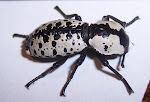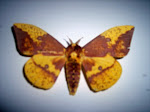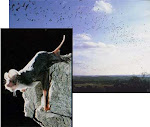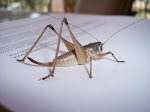Issue 12 - April 8, 2010 Venomous Snakes
Nature at a Distance
Spring is busting out around us right now and many of us are outside a lot, getting the yards ship-shape, spreading the mulch, planting new annuals and enjoying the fresh breeze and warm sunshine. It is a wonderful time of the year, and the promise of Spring is truly the renewal of life.
Don’t ruin it by getting bit by a rattlesnake!
We have, living amongst us, some snakes that will bite if provoked and in some cases that bite can be dangerous and even potentially deadly. This time of the year, they are moving out of their dens, basking on warm rocks and searching for food to nurture their own growing families. That increase in activity, coupled with our own increased outdoor activity, sometimes puts us in close proximity. Try to keep them at a distance.
If you are bitten (aka envenomation)
First, even if you are not certain of the species (i.e. poisonous or not), it's better to take the safest route back to your house or car and seek professional medical assistance ASAP. This is especially true when the victim is a child. The smaller the victim the less time it takes for the venom to spread causing serious tissue damage, even death.
Snake size and envenomation
Although it is commonly believed that baby or young poisonous snakes deliver more concentrated venom and are thus more dangerous, this idea is not supported by scientific evidence. However,
the size of the biting snake is very important because the volume of the poison injected can go up greatly with larger snakes, and this fact plays an important role in the treatment of, and your health-risk, due to the bite.
There are four species of snakes here at Mystic Shores which are
both poisonous and will bite, either you or your pet. That's not to say there aren't plenty of other varieties here which will bite, it's just that these other biters aren't venemous. The three most common types of venomous snakes that we (or our pets) might encounter are collectively called ‘pit vipers’ and this includes the
copperhead, the
cottonmouth and the
rattlesnake. They get their name from the ‘pits’ on each side of the snakes’ face between the nostrils and eyes where heat sensors are located. They also have the common traits of vertically elliptical pupils (Cat’s Eyes) and more or less
triangular-shaped heads. The pit vipers have retractable, syringe like fangs that can inject a poison that mainly breaks down tissue and blood.
Copperheads
Copperheads (
Agkistrodon contortrix), also called ‘Moccasins’, are stout snakes with an average total length of about 30 inches. They have a pale tan to pinkish tan background color with hourglass shaped crossbands that are darker toward the edges. These hourglass shaped patterns are unique to copperheads and serve as a good indicator of the species being observed.


They are found throughout Texas and here in the Hill Country they occupy a variety of habitats. They are often associated with rock outcroppings in mixed woodlands, but can also be found in swampy areas and in dry arroyos as well. During the spring (and fall) of the year they are commonly active during the day, hunting the mice which is their preferred food. During the hot summer months, they are nocturnal and search out their prey in the cool of the night.
The copperhead is the most common of the pit vipers and is responsible for the most bites to humans in the US. Although venomous, it is generally non-aggressive and bites are almost never fatal. Like most pit vipers, these snakes prefer to avoid people and, if given a chance, will normally leave an area without biting. However, unlike other pit vipers, they will often “freeze” instead of crawling away, and many bites result from people accidentally stepping on or near them. This tendency to “freeze” probably evolved because their coloration and camouflage is so excellent. They are nearly impossible to see if they are lying in dead leaves. They will often stay still when approached very closely and generally strike only if physical contact is made.
They often give a ‘warning bite’ or ‘dry bite’ and inject a small amount of venom, if any at all. “Dry bites” are, in fact, very common with copperheads. Some studies indicate more than half the time there is no venom injected. However, a bite from any venomous snake should be taken very seriously and immediate medical attention sought.
Although anti-venom is available for copperhead bites, it is not normally administered because the risk of complications of an allergic reaction to the treatment is worse than the risk from the snakebite itself.
Cottonmouths
The western cottonmouths (
Agkistrodon piscivorus), also sometimes called ‘water moccasins’, are larger relatives of the copperheads. They are normally found along the gulf coast area of Texas down to about Corpus Christi, but they are also found in the lower Hill Country as far west as the San Angelo area. They do well in swampy and marshy areas and, around our neighborhood, would most likely be found around the Guadalupe River and the edges of Canyon Lake. They might also be found near ponds or creeks and can wander a fair distance from water.


When young, the cottonmouth is reddish colored and appears similar to a copperhead. As it matures it gets darker, with lighter coloration near the mouth and lower head. Mature ones have a flat, chunky looking head with a uniform dark brown or nearly charcoal black body. There might be a hint of a darker pattern on its body, which is normally about three feet in length. The underside of its tail has a single row of dark scales, as compared to the double row on the underside of a harmless water snake. (This last bit of info won’t do you much good if you follow my advice about keeping your distance.)

The cottonmouths have a terrible reputation and you often will hear stories about cottonmouths dropping from overhanging branches into boats, and/or nests of cottonmouths chasing fishermen down the shore. These stories are myths because they just aren’t that aggressive toward people. (Only 7% of Texas snakebites are from cottonmouths.) Although they are predominantly nocturnal, it is possible to find one out and about during the daylight hours. A cottonmouth will normally try to crawl or swim away if disturbed. If you come upon one, keep your distance and let it go. Trying to kill the snake may only get it agitated and increase the danger. If agitated, it will rear up and open its mouth and show the write lining as in the picture above. (This is the source of their common name, cottonmouth.) This is a warning from the snake to leave it alone. If sufficiently agitated, it will bite, however, and this should be avoided if at all possible as their bite can cause permanent damage. Bites from cottonmouths are known to bleed a lot too. Their venom is not that much stronger than that of the copperhead, but they inject more of it more often.
Cottonmouths normally swim with their head raised out of the water and their body floating above the waterline, as in the picture above. In contrast, harmless water snakes normally swim underwater or with their heads raised and their bodies submerged.
Rattlesnakes
The Western Diamondback (
Crotalus atrox) is the species that most reacts with humans and is the one responsible for most of the serious venom poisonings in the state of Texas. Bites are serious and prompt medical attention is always recommended.

These rattlesnakes are widely distributed throughout the southwest, and prefer semi-arid rocky canyons as well as nearby meadows. They are often encountered while climbing on rock outcroppings and cliffs. Sounds like the Devils Hollow Creek area here in Mystic Shores doesn’t it? They are frequently found near out-buildings and/or old lumber piles, as these are favorite hunting grounds for the snakes.
They are comparatively large snakes, ranging in length from 3-feet up to 7-feet.

Their coloration ranges from gray to brown with darker “diamond” patterns along the back outlined in white or yellow. The “diamonds” tend to fade toward the tail of the snake. There are two prominent white lines on the face, and the tail is ringed with black and white or light gray bands.

The most distinguishing feature is, of course, their rattle and a new segment is added to the rattle every time the snake sheds. They do wear off however, so the number of segments in a rattle may not be a true indication of the age of the snake. The rattles are vibrated to act as a warning and it is a warning that we should respect. If you hear a rattle (also described as a ‘buzz’) move away and give the snake room to go its way, since the Western Diamondback is a stubborn fellow and has a tendency to stand its ground when agitated.
The Western Diamondback is primarily nocturnal but will be active in the spring during the daytime, and they are known to bask in the sun during the afternoons.
Did you know that the Western Diamondback Rattlesnake helped make culinary history right here in our neighborhood?
About 150 years ago, I think the year was 1855, Pecos Bill was traveling through our area a few miles north of the Guadalupe River along what is now Rt 306. He had been in the area to join the celebration honoring Bob and Pat Ermel for the fine work they had been doing in keeping the trails clear of Comanche arrows. Anyway, Pecos and Mrs. Bill were heading westward in a covered wagon pulled by a fine brace of oxen. Just as they cleared the rise above Devils Hollow Creek, a Diamondback Rattler ten feet long struck the tongue of their wagon. Well, that tongue swelled up so fast that the wheels seized and the oxen couldn’t pull that wagon another foot.
Pecos just strapped on his silver spurs, took his lariat down from the wagon, lassoed himself a tornado that was going west, and rode off into history.
Mrs. Bill muttered something about a “Durn fool!”, walked back to Buddy’s, had a cold longneck, slaughtered the oxen and invented Bar-B-Q.
Coral Snakes
The Texas Coral Snake (
Micrurus tener) is secretive and elusive. Although not often seen, they are venomous and definitely found in Mystic Shores. The one pictured on the left was killed by a resident’s pet dog over on Split Ridge Drive on the north side of our neighborhood this past year.
.jpg)
Coral snakes are members of a family of snakes called the “elapids”, and they are significantly different from the pit vipers in many respects. They are not very large snakes, commonly about 24 inches long and relatively slender with small heads.
Texas Coral Snakes are most known for their striking coloration. They have alternating bands of red, yellow and black. In our region, the order of the bands is indicative of whether they are venomous or not, and a common folk rhyme goes “Red on yellow, kill a fellow: red on black, won’t harm Jack”.
To be safe, all snakes with this type of coloration need to be avoided.

Relatively few coral snake bites are recorded, probably because of the reclusive nature of this reptile. They are not prone to biting and account for less than one percent of all the US snake bites each year. Most coral snake bites occur because of accidental handling of the snake while engaged in an activity like gardening. When confronted by humans, coral snakes will almost always attempt to flee and they bite only as a last resort.
Like all elapid snakes, coral snakes have a pair of small fangs fixed in front of their top jaw. Although their fangs are short, they have a tendency to hold on to a victim when biting, unlike vipers that prefer to strike and let go immediately. Any skin penetration is a medical emergency, however, and requires immediate attention. Coral snake venom is a powerful neurotoxin that paralyzes the breathing muscles. Mechanically assisted breathing and large doses of anti-venom are often necessary to save a life. There is usually only mild pain associated with the bite but breathing difficulties and ptosis (drooping eyelid) can occur within hours.
Every year there are one or two Texans who die from a snake bite. Many more undergo painful experiences, some with lasting effects, from the four venomous snakes that we have in our region. As you work outside this spring, please be careful and keep your distance so that you don’t add to those statistics.
Clay
























.jpg)





